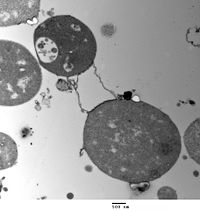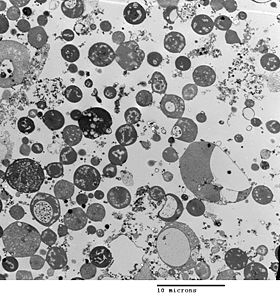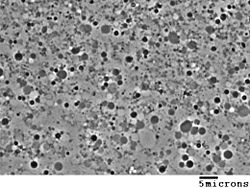
L-form bacteria
Encyclopedia

Strain (biology)
In biology, a strain is a low-level taxonomic rank used in three related ways.-Microbiology and virology:A strain is a genetic variant or subtype of a micro-organism . For example, a "flu strain" is a certain biological form of the influenza or "flu" virus...
s of bacteria
Bacteria
Bacteria are a large domain of prokaryotic microorganisms. Typically a few micrometres in length, bacteria have a wide range of shapes, ranging from spheres to rods and spirals...
that lack cell wall
Cell wall
The cell wall is the tough, usually flexible but sometimes fairly rigid layer that surrounds some types of cells. It is located outside the cell membrane and provides these cells with structural support and protection, and also acts as a filtering mechanism. A major function of the cell wall is to...
s. They were first isolated in 1935 by Emmy Klieneberger-Nobel
Emmy Klieneberger-Nobel
Emmy Klieneberger-Nobel was a German Jewish microbiologist. After having been expelled from Germany by the Nazis and moving to London, she pioneered the study of mycoplasma. In 1935, she discovered and cultured unusual strains of bacteria that lacked a cell wall, naming these strains "L-form...
, who named them "L-forms" after the Lister Institute in London where she was working.
Two types of L-forms are distinguished: unstable L-forms, spheroplasts that are capable of dividing, but can revert to the original morphology, and stable L-forms, L-forms that are unable to revert to the original bacteria.
Some parasitic species of bacteria, such as mycoplasma
Mycoplasma
Mycoplasma refers to a genus of bacteria that lack a cell wall. Without a cell wall, they are unaffected by many common antibiotics such as penicillin or other beta-lactam antibiotics that target cell wall synthesis. They can be parasitic or saprotrophic. Several species are pathogenic in humans,...
, also lack a cell wall, but these are not considered L-forms since they are not derived from bacteria that normally have cell walls.
Appearance and cell division

Bacterial cell structure
Bacteria, despite their simplicity, contain a well-developed cell structure which is responsible for many of their unique biological properties. Many structural features are unique to bacteria and are not found among archaea or eukaryotes...
is determined by the cell wall
Cell wall
The cell wall is the tough, usually flexible but sometimes fairly rigid layer that surrounds some types of cells. It is located outside the cell membrane and provides these cells with structural support and protection, and also acts as a filtering mechanism. A major function of the cell wall is to...
. As L-form has no cell wall, its morphology is different from that of the strain of bacteria from which it is derived. Typical L-form cells are sphere
Sphere
A sphere is a perfectly round geometrical object in three-dimensional space, such as the shape of a round ball. Like a circle in two dimensions, a perfect sphere is completely symmetrical around its center, with all points on the surface lying the same distance r from the center point...
s or spheroids. For example, L-forms of the rod-shaped bacterium Bacillus subtilis
Bacillus subtilis
Bacillus subtilis, known also as the hay bacillus or grass bacillus, is a Gram-positive, catalase-positive bacterium commonly found in soil. A member of the genus Bacillus, B. subtilis is rod-shaped, and has the ability to form a tough, protective endospore, allowing the organism to tolerate...
appear round when viewed by phase contrast microscopy
Phase contrast microscopy
Phase contrast microscopy is an optical microscopy illumination technique of great importance to biologists in which small phase shifts in the light passing through a transparent specimen are converted into amplitude or contrast changes in the image.A phase contrast microscope does not require...
or by transmission electron microscopy
Transmission electron microscopy
Transmission electron microscopy is a microscopy technique whereby a beam of electrons is transmitted through an ultra thin specimen, interacting with the specimen as it passes through...
.
Although L-forms can develop from Gram-positive
Gram-positive
Gram-positive bacteria are those that are stained dark blue or violet by Gram staining. This is in contrast to Gram-negative bacteria, which cannot retain the crystal violet stain, instead taking up the counterstain and appearing red or pink...
as well as from Gram-negative bacteria, in a Gram stain test
Gram staining
Gram staining is a method of differentiating bacterial species into two large groups ....
, the L-forms always colour Gram-negative, due to the lack of a cell wall.
The cell wall is important for cell division
Cell division
Cell division is the process by which a parent cell divides into two or more daughter cells . Cell division is usually a small segment of a larger cell cycle. This type of cell division in eukaryotes is known as mitosis, and leaves the daughter cell capable of dividing again. The corresponding sort...
, which, in most bacteria, occurs by binary fission. The lack of cell wall in L-forms means that division is disorganised, giving rise to a variety of cell sizes, from very tiny to very big.

Cell division
Cell division is the process by which a parent cell divides into two or more daughter cells . Cell division is usually a small segment of a larger cell cycle. This type of cell division in eukaryotes is known as mitosis, and leaves the daughter cell capable of dividing again. The corresponding sort...
usually requires a cell wall and components of the bacterial cytoskeleton such as FtsZ
FtsZ
FtsZ is a protein encoded by the ftsZ gene that assembles into a ring at the future site of the septum of bacterial cell division. This is a prokaryotic homologue to the eukaryotic protein tubulin. FtsZ has been named after "Filamenting temperature-sensitive mutant Z". The hypothesis was that cell...
. The ability of L-form bacteria to grow and divide in the absence of both of these structures is highly unusual, and may represent a form of cell division that was important in early forms of life. This novel mode of division seems to involve the extension of thin protrusions from the cell's surface and these protrusions then pinching off to form new cells.
Generation in cultures
L-forms can be generated in the laboratory from many bacterial species that usually have cell walls, such as Bacillus subtilisBacillus subtilis
Bacillus subtilis, known also as the hay bacillus or grass bacillus, is a Gram-positive, catalase-positive bacterium commonly found in soil. A member of the genus Bacillus, B. subtilis is rod-shaped, and has the ability to form a tough, protective endospore, allowing the organism to tolerate...
or Escherichia coli
Escherichia coli
Escherichia coli is a Gram-negative, rod-shaped bacterium that is commonly found in the lower intestine of warm-blooded organisms . Most E. coli strains are harmless, but some serotypes can cause serious food poisoning in humans, and are occasionally responsible for product recalls...
. This is done by inhibiting peptidoglycan
Peptidoglycan
Peptidoglycan, also known as murein, is a polymer consisting of sugars and amino acids that forms a mesh-like layer outside the plasma membrane of bacteria , forming the cell wall. The sugar component consists of alternating residues of β- linked N-acetylglucosamine and N-acetylmuramic acid...
synthesis with antibiotics or treating the cells with lysozyme
Lysozyme
Lysozyme, also known as muramidase or N-acetylmuramide glycanhydrolase, are glycoside hydrolases, enzymes that damage bacterial cell walls by catalyzing hydrolysis of 1,4-beta-linkages between N-acetylmuramic acid and N-acetyl-D-glucosamine residues in a peptidoglycan and between...
, an enzyme that digests cell walls. The L-forms are generated in a culture medium that is the same osmolarity as the bacterial cytosol
Cytosol
The cytosol or intracellular fluid is the liquid found inside cells, that is separated into compartments by membranes. For example, the mitochondrial matrix separates the mitochondrion into compartments....
(an isotonic solution), which prevents cell lysis by osmotic shock
Osmotic shock
Osmotic shock or osmotic stress is a sudden change in the solute concentration around a cell, causing a rapid change in the movement of water across its cell membrane. Under conditions of high concentrations of either salts, substrates or any solute in the supernatant, water is drawn out of the...
. L-form strains can be unstable, tending to revert to the normal form of the bacteria by regrowing a cell wall, but this can be prevented by long-term culture of the cells under the same conditions that were used to produce them..
Some studies have identified mutation
Mutation
In molecular biology and genetics, mutations are changes in a genomic sequence: the DNA sequence of a cell's genome or the DNA or RNA sequence of a virus. They can be defined as sudden and spontaneous changes in the cell. Mutations are caused by radiation, viruses, transposons and mutagenic...
s that occur, as these strains are derived from normal bacteria. One such point mutation is in an enzyme involved in the mevalonate pathway of lipid metabolism
Lipid metabolism
Lipid metabolism refers to the processes that involve the intercourse and degradation of lipids.The types of lipids involved include:* Bile salts* Cholesterols* Eicosanoids* Glycolipids* Ketone bodies* Fatty acids - see also fatty acid metabolism...
that increased the frequency of L-form formation 1,000-fold. The reason for this effect is not known, but it is presumed that the increase is related to this enzyme's role in making a lipid important in peptidoglycan synthesis.
Another methodology of induction relies on nanotechnology
Nanotechnology
Nanotechnology is the study of manipulating matter on an atomic and molecular scale. Generally, nanotechnology deals with developing materials, devices, or other structures possessing at least one dimension sized from 1 to 100 nanometres...
and landscape ecology
Landscape ecology
Landscape ecology is the science of studying and improving relationships between urban development and ecological processes in the environment and particular ecosystems...
. Microfluidics
Microfluidics
Microfluidics deals with the behavior, precise control and manipulation of fluids that are geometrically constrained to a small, typically sub-millimeter, scale.Typically, micro means one of the following features:* small volumes...
devices can be built in order to challenge peptidoglycan
Peptidoglycan
Peptidoglycan, also known as murein, is a polymer consisting of sugars and amino acids that forms a mesh-like layer outside the plasma membrane of bacteria , forming the cell wall. The sugar component consists of alternating residues of β- linked N-acetylglucosamine and N-acetylmuramic acid...
synthesis by extreme spatial confinement. After biological dispersal
Biological dispersal
Biological dispersal refers to species movement away from an existing population or away from the parent organism. Through simply moving from one habitat patch to another, the dispersal of an individual has consequences not only for individual fitness, but also for population dynamics, population...
through a constricted (sub-micrometre scale) biological corridor connecting adjacent micro habitat patches, L-form-like cells can be derived .
Significance and applications
Laboratory-generated L-form strains have not been proven to exist in nature. Some publications have argued that L-form bacteria might cause human diseases, but, as the evidence that links these organisms to disease is fragmentary and frequently contradictory, this hypothesis remains controversial. The two extreme viewpoints on this question are that L-form bacteria are either laboratory curiosities of no clinical significance or important but unappreciated causes of disease. Research on L-form bacteria is continuing. For example, L-form organisms have been observed in mouse lungs after experimental inoculation with Nocardia caviaeNocardia
Nocardia is a genus of weakly staining Gram-positive, catalase-positive, rod-shaped bacteria. It forms partially acid-fast beaded branching filaments . It has a total of 85 species. Some species are non-pathogenic while others are responsible for nocardiosis. Nocardia are found worldwide in soil...
, and a recent study suggested that these organisms may infect immunosuppressed
Immunosuppression
Immunosuppression involves an act that reduces the activation or efficacy of the immune system. Some portions of the immune system itself have immuno-suppressive effects on other parts of the immune system, and immunosuppression may occur as an adverse reaction to treatment of other...
patients having undergone bone marrow transplants. The formation of strains of bacteria lacking cell walls has also been proposed to be important in the acquisition of bacterial antibiotic resistance
Antibiotic resistance
Antibiotic resistance is a type of drug resistance where a microorganism is able to survive exposure to an antibiotic. While a spontaneous or induced genetic mutation in bacteria may confer resistance to antimicrobial drugs, genes that confer resistance can be transferred between bacteria in a...
.
L-form bacteria may be useful in research on early forms of life, and in biotechnology
Biotechnology
Biotechnology is a field of applied biology that involves the use of living organisms and bioprocesses in engineering, technology, medicine and other fields requiring bioproducts. Biotechnology also utilizes these products for manufacturing purpose...
. These strains are being examined for possible uses in biotechnology as host strains for recombinant protein expression
Protein expression
Protein expression is a subcomponent of gene expression. It consists of the stages after DNA has been translated into polypeptide chains, which are ultimately folded into proteins...
. Here, the absence of a cell wall can allow production of large amounts of secreted proteins that would otherwise accumulate in the periplasmic space
Periplasmic space
The periplasmic space or periplasm is a space between the peptidoglycan cell wall and inner membrane of Gram-negative bacteria or the equivalent space outside the inner membrane of Gram-positive bacteria. It may constitute up to 40% of the total cell volume in Gram-negative species, and is...
of bacteria. The accumulation of proteins in the periplasmic space can be toxic to the bacteria, which may reduce the yield of the expressed proteins.
See also
- ProtoplastProtoplastProtoplast, from the ancient Greek πρῶτον + verb πλάθω or πλάττω , initially referred to the first organized body of a species.Protoplast has several biological definitions:...
- SpheroplastSpheroplastA spheroplast is a cell from which the cell wall has been almost completely removed, as by the action of penicillin. The name stems from the fact that after a microbe's cell wall is digested, membrane tension causes the cell to acquire a characteristic spherical shape...
- MycoplasmataceaeMycoplasmataceaeThe Mycoplasmataceae is a family of bacteria in the order Mycoplasmatales. This family comprises the species Mycoplasma and Ureaplasma.In 1967 the Order Mycoplasmatales was incorporated into the class Mollicutes....
— lack peptidoglycan, but possess a mycolic acid layer for stability - UltramicrobacteriaUltramicrobacteriaUltramicrobacteria are bacteria that are considerably smaller than normal bacterial cells and are 0.3 to 0.2 micrometres in diameter. This term was first used in 1981, to refer to cocci in seawater that were less than 0.3 μm in diameter. These cells have also been recovered from soil and appeared...
External links
- Errington Group at Newcastle University
- Scientists explore new window on the origins of life 2009 Newcastle University press release

